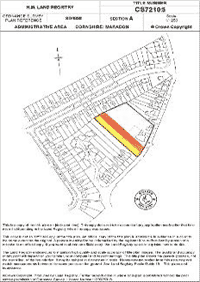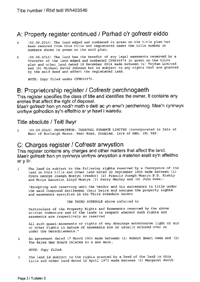Joint Tenancy or Tenancy in Common
Contents
Overview
The distinction between a joint tenancy and a tenancy in common is crucial to know, as you’re selling or otherwise disposing of the property will be dealt with differently. The distinction between the two is not broadcast in the Land Registry documents, but is simple to know once you know what you are looking for.
Registration of a Joint Tenancy
In the absence of a request to register as a tenancy in common the Land Registry will effect registration as a joint tenancy.
The following is an extract from the Proprietorship Register section (Section B) of a Title Register where the owners have a beneficial joint tenancy:
B: Proprietorship Register
This register specifies the class of title and identifies the owner. It contains any entries that affect the right of disposal.
Title absolute
1 (30.10.2010) Proprietor: James Alexander Jones and Juliette Margaret Jones of 10 Strathfield Avenue, Leicester LE19 3SR.
Registration of a Tenancy in Common
The following is an extract from Section B of the Proprietorship Section of a Title Register as it would be if a tenancy in common was registered:
B: Proprietorship Register
This register specifies the class of title and identifies the owner. It contains any entries that affect the right of disposal.
Title absolute
1 (30.10.2010) Proprietor: James Alexander Jones and Juliette Margaret Jones of 10 Strathfield Avenue, Leicester LE19 3SR.
RESTRICTION: No disposition by a sole proprietor of the registered estate (except a trust corporation) under which capital money arises is to be registered unless authorised by an order of the court.
As will be seen the only difference between the two entries in the Register is the existence of the Restriction. So that is what you must look for. The Restriction is entered by the Land Registry whenever an application is made to create a tenancy in common. If there is no such entry then the property is registered as a beneficial joint tenancy.
Effect of a Joint Tenancy
People who own a property as beneficial joints tenants each own 100% of the property, i.e. they do not have independent shares, so that if one dies, the ownership remains the same, the survivor owns 100% of the property. This means that joint tenants cannot leave a share of the property when making a Will.
Effect of a Tenancy in Common
Tenants in common are able to Will their shares in the property, according to the relative percentage that they each own. If they do not specify their individual percentage ownerships it may be necessary to determine what contributions they have each made to the property.
The Deed creating a tenancy in common will normally specify the individual percentages.
Severance of the Joint Tenancy
Either of the Joint tenants can, at any time, serve a notice of severance of the joint tenancy on the other joint tenants, which has the effect of converting the ownership to a tenancy in common. An application for a Restriction, with a copy of the Notice of Severance, should be made to the Land Registry. The Notice of Severance will indicate the respective ownership percentages.
Procedure to Sever a Joint Tenancy
- Prepare a Notice of Severance (see below).
- Serve the Notice in duplicate on the other joint tenants, and obtain a receipt on the copy notice.
- Complete form SEV.
- Send to the Land Registry:
There is no fee payable to the Land Registry for this service.
The Land Registry’s address is:
Land Registry Citizen Centre
PO Box 74
Gloucester
GL14 9BB.
Template Notice of Severance
Below is an example template that can be used for giving notice of severance of a joint tenancy. The italised parts in brackets should be replaced with your relevent information. We have also provided links to downloadable versions in Microsoft World (.doc) and Portable Document Format (.pdf) formats.
NOTICE OF SEVERANCE OF JOINT TENANCY
Applican Name: (applicant's name in full)
To: (other joint tenants names in full)
Property: (your property address)
Title Number: (your Property's Title Number found in the Title Register)
In accordance with section 36 (2) of the Law of Property Act 1925 I hereby give you notice of my wish, as one of the joint tenants, to sever the joint tenancy in equity of the above property, which from the date hereof will no longer be held by us as beneficial joint tenants, but as beneficial tenants in common. In doing so the rule of survivorship will no longer apply to the property.
Accordingly I give you notice of my desire to sever as from this day the joint tenancy in equity of and in the above property now held by you and me as joint tenants both in law and in equity so that the property shall from the date of this notice belong to you and me as Tenants in Common in the following shares as if there had been an actual severance:
Shares:
(Name of applicant and percentage shares)
(Name/s of other joint tenants and percentage shares)
I acknowledge receipt of the original notice, of which this is a copy.
Signature of joint tenant/s receiving this notice:
.......................................
(Name)
Date: (date the document was signed)
Title Register
The Land Registry Title Register holds data relating to the property ownership, purchase price, mortgage, tenure, covenants, rights of way, leases and class of title.
£19.95Title Plan
The Title Plan shows an outline of the property and its immediate neighbourhood, and uses colours to identify rights of way, general boundaries and land affected by covenants.
£19.95Associated Documents
Deeds creating Restrictions, Covenants, Easements, etc. are often kept digitally by the Land Registry and made available for sale due to their invaluable detail and content to assist in further understanding the Restrictions, etc.
£29.95


